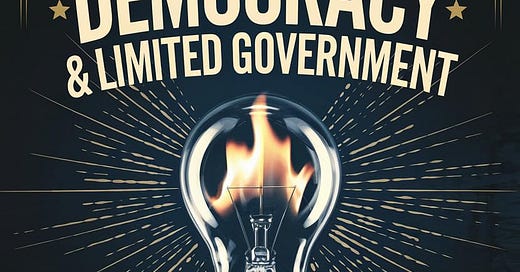How long till the Sacklers get Brain Thompsoned? Political Infighting
"Herding Cats" with False Dichotomies: How Mobligarchs Rule Over You.
Most other people on “the left” are taken in by the false dichotomy of "left" versus "right" and have little or no knowledge of economics. All that is no accident. Oligarchs like to create false dichotomies to compel conclusions they desire no matter who "wins" illusory contests for control. False dichotomies can be used to constrain outcomes to those desired by your oligarchic masters and we can name names Rockefeller, Kennedy, DuPont, Morgan, Ford, just look carefully at various “foundations” names to get the message, cur.
“Right” wing people, usually labelled “extremists” sometimes notice the dichotimization, unlike the so-called “left”. They almost always mischaracterize such false dichotomization as “Hegelian dialectic”, when in fact it is “only” false dichotomy. False dichotomies go hand-in-glove with "salami slicing". Elites, in other words oligarchs, front-men declare themselves to be the moderate responsible middle and then generate or take advantage of people on the “extreme” "left" and "right", chop chop “inevitable” “natural” “foreordained” and “logical” conclusion, prole.
The creation of false dichotomies is a tool often used by oligarchical elites to maintain control and manipulate public opinion. This tactic involves presenting two opposing viewpoints as the only possibilities, when in reality, there may be a spectrum of alternative options. By limiting the discussion to these two extremes, usually cast as "left" versus "right", the oligarchy can ensure that the outcome will always favor their interests, regardless of which side "wins". "Right wing" elements, usually cast as "right wing extremists", often do notice this fact, but then mistakenly call it "the Hegelian dialectic". However, the strategy of false-dichotomization is distinct from a philosophical framework for understanding the development of ideas and historical events through the conflict of opposing forces that Aristotle, Hegel, and Marx describe.
In the context of economics, the false dichotomy of "left" and "right" can be particularly misleading. Many individuals on the "left" have a limited understanding of economics. Even basic economic principles like supply and demand, opportunity costs, and tax incidence evade comprehension by many on the "left".
"Left" wing thinkers and "right" wing thinkers are fairly easily goaded into self-polarization. They buy into the "left" "right" false dichotomy and then fight each other viciously. They are in this way fairly easily induced into (mutual!) self-destruction, at little or no cost to their common opponents, the liberal elitist oligarchs. They are so easily goaded, herded, and destroyed because they suffer from ignorance about economics (on the "left") and social science (on the "right"). They are thereby fairly easily lured and led into working toward pre-ordained outcomes desired by oligarchs who are indifferent to "left" "right" labels.
Oligarchs are however rather predictable: "follow the money", oligarchs are driven by economism, a voracious desire for wealth. Oligarchs may not be self-indulgent or even greedy but they are relentless and voracious in the pursuit of wealth, for whatever reasons and purposes. Professional politicians in contrast seek public fame and to shape and influence public policy. This split explains where inroads to trammel oligarchy, “liberalism” and elitism may be found.
False dichotomies work hand-in-glove with "sausage slicing," where contentious policies are advanced in small, palatable increments. Slicing off on extreme seems reasonable and prudent. Then of course once begun not half done and voila the opposite extreme is also sliced off. Before long all that is left is, you guessed it, the elitist “liberal” oligarchs “foreordained” “central” conclusion. Each slice looked reasonable, and this victory-by-steps allows oligarchs to achieve their objectives without sparking widespread resistance, “boiling the frog”.
A key area where the false dichotomy is most damaging is in economics. Many "left-wing" thinkers struggle with basic principles like supply and demand, tax incidence, or the concept of opportunity costs. On the other hand, "right-wing" perspectives often dismiss the social implications of economic policies, compounding the problem.
Supply-side economics provides a framework to understand how taxes influence investment and economic behavior. Tax laws are not merely tools for revenue collection but powerful levers for steering economic activity. For examples:
Tax Credits: Incentivize investments in specific areas like renewable energy or affordable housing.
Depreciation & Amortization: Encourages businesses to undertake long-term investments by allowing gradual deduction of capital expenses over time.
Tax Deductions: Reduce taxable income for expenses like education or healthcare, fostering spending in these critical sectors.
Charitable Donations: Favorable tax treatment of donations encourages wealth redistribution from the rich to the poor via philanthropy.
These mechanisms demonstrate how taxes can be used to guide economic priorities. For instance, offering tax breaks for pension contributions ensures long-term savings, while deductions for insurance premiums promote financial security. By taxing the rich more effectively and ensuring compliance, governments can create systems where public investment benefits society as a whole. Yet, these complexities are often lost in the "left"-"right" framing, which oversimplifies taxation as punitive or redistributive without appreciating its nuances.
To resist oligarchic control, it is crucial to recognize the tactics of false dichotomies and sausage slicing. These methods exploit ignorance and polarization. By rejecting binary thinking we can challenge the "preordained" outcomes. Education equips people to see beyond false dichotomies to build something better.
Conclusion
False dichotomies are a powerful tool for oligarchic control. They enable oligarchs to drive political outcomes and constrain them to a range of outcomes acceptable to oligarchy. The false dichotomy of "left" versus "right" is a calculated tool of oligarchic manipulation, reinforced by the gradualism of sausage slicing. Ignorance of basic economic principles like the law of supply and demand, tax incidence, and opportunity costs or economic systems and simplistic narratives about taxation perpetuate this control. By exposing these tactics and fostering informed discourse, individuals can dismantle the structures that enable oligarchs to "herd cats" and reclaim agency in shaping a fairer society.
Free Law eBooks till Friday!
The Law Dictionary
Tort Law Decoded: Your Path to Success! Quizmaster Q&A Quizbook for Law Exams & Bar Review (vol. II)
Constitutional Law Quiz Questions and Explanatory Answers for Law School and the Bar Exam
Quizmaster Point of Law: Contract Law
Civil Procedure
Real Estate Transactions Law
CHINESE VOCABULARY COGNATES
https://www.cnn.com/2024/12/10/middleeast/israel-syria-assad-strikes-intl/index.html
WOTD=False Dichotomy. Sample sentence: A false dichotomy is a logical fallacy that occurs when an issue is inaccurately framed as having only two mutually exclusive options, despite the existence of additional alternatives.
Translations:
French: Fausse dichotomie (pronounced "fohs duh-shoh-toh-mee")
Spanish: Falsa dicotomía (pronounced "fahl-sah dee-koh-toh-mee-ah")
German: Falsche Dichotomie (pronounced "fahl-shuh dee-koh-toh-mee")
Estonian: Väär valevalik (pronounced "vayr vah-leh-vah-leek")
Ukrainian: Хибна дихотомія (Khybna dykhotomiya, pronounced "kheeb-nah dee-khoh-toh-mee-yah")
Russian: Ложная дихотомия (Lozhnaya dikhotomiya, pronounced "lozh-nah-yah dee-khoh-toh-mee-yah")
Chinese (Simplified): 虚假二元论 (xū jiǎ èr yuán lùn, pronounced "shoo jyah er ywan loon")
Sample Sentence Translations:
French: Une fausse dichotomie est un sophisme qui se produit lorsqu'une question est présentée de manière inexacte comme ayant seulement deux options mutuellement exclusives, malgré l'existence d'alternatives supplémentaires.
Spanish: Una falsa dicotomía es un error lógico que ocurre cuando un asunto se presenta de manera inexacta como si solo tuviera dos opciones mutuamente excluyentes, a pesar de la existencia de alternativas adicionales.
German: Eine falsche Dichotomie ist ein logischer Fehlschluss, der auftritt, wenn eine Frage ungenau als nur zwei gegenseitig ausschließende Optionen dargestellt wird, trotz der Existenz zusätzlicher Alternativen.
Estonian: Väär valevalik on loogiline eksitus, mis tekib siis, kui küsimus esitatakse ebapäraselt kui ainult kaks vastastikku välistuvat varianti, kuigi on olemas ka täiendavad alternatiivid.
Ukrainian: Хибна дихотомія - це логічна омана, яка виникає, коли питання подається неточно як тільки дві взаємовиключні варіанти, попри існування додаткових альтернатив.
Russian: Ложная дихотомия - это логическая ошибка, которая возникает, когда вопрос представляется неточно как только два взаимоисключающих варианта, несмотря на существование дополнительных альтернатив.
Chinese (Simplified): 虚假二元论是一种逻辑谬误,当问题被不准确地框定为只有两个相互排斥的选项时就会发生这种情况,尽管存在其他的替代方案。
A false dichotomy, also known as a false dilemma or either-or fallacy, is a logical fallacy that occurs when an issue is inaccurately framed as having only two mutually exclusive options, despite the existence of additional alternatives. This oversimplification can mislead individuals into believing they must choose between two extremes, disregarding other viable possibilities[1][2][4].
Characteristics of False Dichotomies
Limited Options: The fallacy presents a situation as if there are only two choices available, often ignoring a spectrum of other possibilities that could also be relevant[2][4].
Mutual Exclusivity: It asserts that the two presented options cannot coexist, which may not be true in reality. For instance, one might be forced to choose between two extremes while other moderate or alternative options are overlooked[3][5].
Persuasive Use: False dichotomies are frequently employed in persuasive contexts, such as political discourse or advertising, to manipulate opinions by simplifying complex issues into binary choices[2][4].
Examples
Political Context: "You are either with us or against us." This statement ignores the possibility of neutrality or support for different aspects of a situation.
Social Issues: "If you don’t support this law, you support chaos." This framing excludes the possibility of advocating for alternative solutions that do not lead to chaos.
Conclusion
Recognizing false dichotomies is crucial for critical thinking and effective argumentation. By identifying these fallacies, individuals can better navigate discussions and make informed decisions without being constrained by misleading binary choices[3][5].
Citations: [1] https://en.wikipedia.org/wiki/False_dichotomy [2] https://quillbot.com/blog/reasoning/false-dichotomy-fallacy/ [3] https://www.vaia.com/en-us/explanations/english/rhetoric/false-dichotomy/ [4] https://www.scribbr.com/fallacies/false-dilemma-fallacy/ [5] https://www.grammarly.com/blog/rhetorical-devices/false-dilemma-fallacy/ [6] https://www.dictionary.com/browse/false-dichotomy
Citations:
[1] https://en.wikipedia.org/wiki/False_dichotomy
[2] https://quillbot.com/blog/reasoning/false-dichotomy-fallacy/
[3] https://www.vaia.com/en-us/explanations/english/rhetoric/false-dichotomy/
[4] https://www.scribbr.com/fallacies/false-dilemma-fallacy/
[5] https://www.grammarly.com/blog/rhetorical-devices/false-dilemma-fallacy/
[6] https://www.dictionary.com/browse/false-dichotomy













